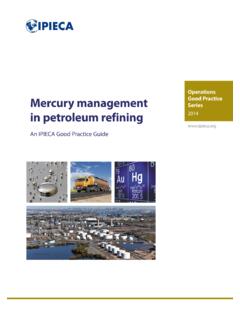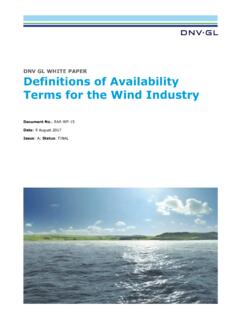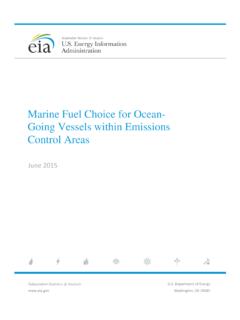Transcription of OIL AND GAS FORECAST TO 2050 - OurEnergyPolicy
1 SAFER, SMARTER, GREENEROIL AND GAS FORECAST TO 2050 Energy Transition outlook 2017dnv gl energy transition outlook oil and gasIncreased dialogue and collaboration is required to drive the energy transitionThe world s energy system is going through a transition. Over the next thirty years it will change significantly in its composition as it decouples from carbon, population and economic growth. DNV GL s Energy Transition outlook seeks to understand the nature and pace of this change. We have created an independent FORECAST of what we believe to be the most likely energy future. It will inform our own strategic choices over the years to come, and we hope it will also provide useful insight to our customers, partners and other stakeholders. We FORECAST energy demand to flatten, mainly due to increased efficiencies in the use of energy, after 2030. Industry across energy sources and throughout the energy value chain will continue to make energy available, affordable and won t be a silver bullet for sustainable energy production; instead the world will benefit from a portfolio of technically sophisticated and cost-effective energy.
2 The oil and gas industry will continue to play an important role in this portfolio and hydrocarbons will account for 44% of the total energy mix in 2050. Key areas of demand for fossil fuels will be within heavy forewordelisabeth t rstadceo dnv gl oil & gas 2transportation, air and shipping. Gas is predicted to become the largest energy carrier from 2033 to the end of our FORECAST s energy system will be characterized by enhanced efficiency with reduced waste of energy, cost and resources in all stages of the value chain. For oil and gas this not only means enhanced recovery and cost efficiency, but also the use of each energy source and carrier where it is most effective. A plateau in demand and cheaper resources will lead to tough competition between energy sources where supply exceeds demand. There will be an increased need and opportunity to serve energy systems with a flexible mix of sources and carriers, and to identify and exploit synergies between these.
3 This transition does not come by itself, and the details of the energy system will vary significantly between regions and countries. Increased dialogue and collaboration is required to drive the transition: between industry, policymakers and regulators, between various parts of the energy industry and between countries and regions. We hope that this report can trigger and support this dialogue. foreword elisabeth t rstad3dnv gl energy transition outlook oil and gasWe wish to thank experts from industry and academia for reviewing early drafts of this report. Their comments and suggestions have been of great value, and any remaining errors and inelegancies remain our own. Our external collaborators are: This report has been prepared by DNV GL as a cross-disciplinary exercise between DNV GL s Oil & Gas business area and a core research team in our central R&D unit, including:bo cerup-simonsen the danish hydrocarbon technology centre, technical university of denmarkhelge hove haldorsen statoil mexicoadrian luckins bpkaren sund sund energytrude sundset gassnova DNV GL - Group Technology and Research: Kjersti Aalbu, J rg Aarnes, Sverre Alvik, Bent Erik Bakken, Hendrik Brinks, Christos Chryssakis, Caroline Brun Ellefsen, Anne Louise Koefoed, Onur zg n, Asun , Bj rn Johan GL - Oil & Gas.
4 Rene Bahlmann, Graham Bennett, Rob Coveney , Vijay Gopal, Rich Green, Torleiv Grimsrud, Kaare Helle, Hamed Hamedifar, Pui Ling Ho, Asmund Huser, Rolf Benjamin Johansen, Johan Knijp, Koheila Molazemi, Albert van den Noort, Sailesh Patel, Paula Schulze, Cathrine Torp, Elisabeth T rstad, Kenneth Vareide, Asle Ven s, Maurice Vos, Ivan Wapstra, Andrew Williams, Ton van Wingerden. acknowledgementsHISTORICAL DATA This work is partially based on the World Energy Balances database developed by the International Energy Agency, OECD/IEA 2016 but the resulting work has been prepared by DNV GL and does not necessarily reflect the views of the International Energy Agency. For energy related charts, historical (up to and including 2014) numerical data is mainly based on IEA data from World Energy Balances OECD/IEA 2016, , Licence: ; as modified by DNV 36 46 54 62 687273executive summaryintroductionoil and gas demand forecasttrends and implicationsthe next five yearsreferenceskey to world regions covered in our modelonshore and offshore oil exploration and productiononshore and offshore gas exploration and productionmid- and downstream technologiesemerging and enabling technologies for decarbonizationdigitalization and automation5contentsdnv gl energy transition outlook oil and gas1 EXECUTIVE SUMMARYdnv gl energy transition outlook oil and gasOil and gas will play a very important role in the energy mix throughout our forecasting period.
5 Although we expect renewable energy sources to take an increasing share of this mix, we FORECAST oil and gas to account for 44% of the world s primary energy supply in 2050, down from 53% today. Investment will be needed to add new oil and gas production capacity, and to operate existing assets safely and sustainably over this period, to deliver output levels that can meet predicted energy transition will be characterized by many sub-transitions in the next three decades. Based on the DNV GL model of the world energy system, we FORECAST that global final energy demand will flatten at 430 exajoules (EJ) from 2030 onwards (7% higher than 2015), reflecting accelerating improvement in global energy efficiency, driven largely by the electrification of the world s energy system and an increased share of oil and gas industry will play a very important role in the energy mix throughout our forecasting period The stage is set for gas to become the world s primary energy source towards 2050, and the last of the fossil fuels to experience peak demand, which will occur in 2035 according to our model.
6 Gas can play a central role in supporting energy security alongside variable renewables during the transition. There are opportunities to improve its carbon footprint by curtailing methane emissions from its value chain and through improving the economics of large-scale carbon capture and storage (CCS) for gas-fuelled power generation. We expect demand for oil to be at its maximum in 2022 and the high point for coal has already 1 | executive summaryThe growing role of gas, and declining demand for coal and oil will reduce the carbon intensity of fossil fuel use, as oil and gas majors continue to focus on reducing the carbon footprint of their business portfolios. However, our model forecasts that global warming will likely reach degrees Celsius (oC) above pre-industrial levels. This is not in line with the COP 21 Paris Agreement on climate change, which aims to keep global warming to well below 2oC .Against this background, this report provides an in-depth analysis of the implications of our model across the oil and gas value chain.
7 UPSTREAMC onventional oil production will play an important role in the global energy mix for decades to come. Conventional onshore oil production will decline per year on average until 2050, but will still account for more than 50% of all oil production by onshore oil production will roughly double to around 22 million barrels per day (Mbpd) by 2035 when it will have nearly a 30% share of all global crude oil oil production will still be important in 2050, but it is set to more than halve from today s onshore gas production will start declining from about 2020 along with offshore gas production while unconventional onshore gas rises to a plateau. Conventional onshore gas production will fall strongly in North America while rising in North East Eurasia, and Middle East and North Africa. Production will remain high throughout the period to onshore gas will retain an important share of gas supply in North America with production increasing towards 2025 and then declining slightly until such as subsea processing and unmanned tiebacks will improve the economics of oil and gas production from deepwater and/or harsh environment offshore fields.
8 Adopting industry-wide standards can reduce scope inflation, which contributed to compound annual growth of more than 10% in capital expenditure (capex) per barrel of oil between 1999 and Enhanced intra-sector collaboration can reduce inefficiencies at interfaces along the supply chain. Increased use of digitalization and automation will also play a leading role in keeping production costs down, and aligns with our FORECAST of a slowly reducing cost trade forecasts and other results from our model support the requirement for: new pipelines including those for cross-border transmission; and liquefied natural gas (LNG) terminals of varying scale. We predict an average annual increase in seaborne natural gas trade (LNG and liquefied petroleum gas (LPG) combined) from 340 million tonnes per annum (Mtpa) today to around 640 Mtpa in 2050. Gas transport trends will drive globalization of markets for gas trading. 9dnv gl energy transition outlook oil and gasThe stage is set for gas to become the world s primary energy source towards 2050 With gas demand set to persist until at least 2050, there will be increased costs and activity on older pipeline systems in world regions (see References) such as North America, Europe, North East Eurasia and the Middle East and North Africa.
9 In North America in particular, pipeline systems continue to be repurposed and undergo change of service due to shifts in where gas is produced and consumed, and LNG exports being gas transmission system operators will progressively incorporate advances in artificial intelligence, augmented reality, the industrial Internet of Things and machine learning into systems and processes. This will assist them to maintain, repair and operate networks safely and cost-efficiently, and provide customers, regulators and partners with tailored analyses of large volumes of , customers will buy units of energy rather than volumes of a fuel. More accurate and consistent measurement of the energy value delivered will be required. Greater computing power and more advanced data analytics will allow gas distribution system operators to manage more complex data and customize the results for internal and external refinery oil demand will reach a high by 2022 at only 2% above 2017 levels, followed by a 39% decline by 2050, due largely to significantly reduced transport sector oil demand.
10 We expect greater focus in mature markets on producing cleaner, higher-grade transport fuels. Indian and Sub-Saharan Africa markets will likely concentrate on building scalable and operationally flexible refinery predict a 30% decline in petrochemicals production levels over 30 years, driven by regional transitions in product demand and in feedstock supply, which will show increasing gas reliance as oil consumption declines. Globally, we foresee a drive, aided by greater and more sophisticated digitalization, to optimize lifecycle performance for existing and new-build facilities throughout the refining and petrochemicals sectors. 10chapter 1 | executive summary11dnv gl energy transition outlook oil and gas2 INTRODUCTIONdnv gl energy transition outlook oil and gasAround 70% of our business is energy-related. We provide classification, technical assurance, software and independent expert advisory services to the maritime, oil and gas, and the power and renewable energy industries.










